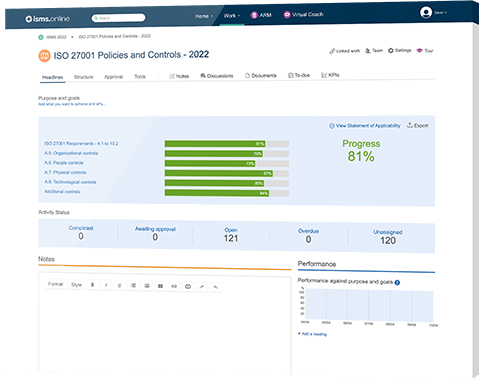
Control 5.11 states that personnel and other interested parties as appropriate should return all the organisation’s assets in their possession upon change or termination of their employment, contract or agreement.
This means that the organisation must have a written policy that defines clear rules for returning assets upon termination. Organisations must also have personnel that will confirm receipt of returned assets, and ensure that assets are properly inventoried and accounted for.
An information asset is any kind of data or information that has value to an organisation. Information assets can include physical documents, digital files and databases, software programs, and even intangible items like trade secrets and intellectual property.
Information assets can have value in a variety of ways. They may contain personally identifying information (PII) about customers, employees or other stakeholders that could be used by bad actors for financial gain or identity theft. They could contain sensitive information about your organisation’s finances, research or operations that would provide a competitive advantage to your competitors if they were able to get their hands on it.
This is why it is important that staff and contractors whose business are terminated with an organisation are compelled to return all such assets in their possession.
The new ISO 27002:2022 standard includes attribute tables that were not included in the previous 2013 standard. Controls are classified based on their attributes. You can also use these attributes to match your control selection with commonly used industry terms and specifications.
Attributes for control 5.11 are:
| Control Type | Information Security Properties | Cybersecurity Concepts | Operational Capabilities | Security Domains |
|---|---|---|---|---|
| #Preventive | #Confidentiality #Integrity #Availability | #Protect | #Asset management | #Protection |
Control 5.11 is designed to protect the organisation’s assets as part of the process of changing or terminating employment, contract or agreement. The intent of this control is to prevent unauthorised individuals from retaining assets (e.g., equipment, information, software, etc.) that belong to the organisation.
When employees and contractors leave your organisation, you have to make sure that they don’t take any sensitive data with them. You do that by identifying any potential threats and monitoring the user’s activities before their departure.
This control is to ensure that the individual does not have access to the IT systems and networks when they are terminated. Organisations should establish a formal termination process which ensures that individuals are not able to gain access to any IT systems after their departure from the organisation. This can be done by revoking all permissions, disabling accounts and removing access from building premises.
Procedures should be in place to ensure that employees, contractors, and other relevant parties return all organisational assets that are no longer required for business purposes or are due for replacement. Organisations may also want to perform a final check of the individual’s work area to ensure that all sensitive information has been returned.
For example:
In order to meet the requirements for control 5.11, the change or termination process should be formalised to include the return of all previously issued physical and electronic assets owned by or entrusted to the organisation.
The process should also ensure that any and all access rights, accounts, digital certificates and passwords are removed. This formalisation is especially important in cases where a change or termination occurs unexpectedly, such as death or resignation, in order to prevent unauthorised access to organisation assets which could lead to a data breach.
The process should ensure that all assets are accounted for, and that they have all been returned/disposed of in a secure manner.
According to control 5.11 of ISO 27002:2022, the organisation should clearly identify and document all information and other associated assets to be returned which can include:
a) user endpoint devices;
b) portable storage devices;
c) specialist equipment;
d) authentication hardware (e.g. mechanical keys, physical tokens and smartcards) for information systems, sites and physical archives;
e) physical copies of information.
This can be achieved through a formal checklist containing all necessary items to be returned/disposed of and completed by the user upon termination, along with any necessary signatures confirming that the assets have been returned/disposed of successfully.

We’ll give you an 81% headstart
from the moment you log in
Book your demo
The new 2022 revision of ISO 27002 was published on February 15, 2022, and is an upgrade of ISO 27002:2013.
The control 5.11 in ISO 27002: 2022 is not a new control, rather, it is a modification of control 8.1.4 – return of assets in ISO 27002:2013.
Both controls are essentially the same with near similar language and phraseology contained in the implementation guidelines. However, control 5.11 in ISO 27002:2022 comes with an attributes table that allows users to match the control with what they are implementing. Also, control 5.11 in ISO 27002:2022 listed assets that can fall under what should be returned at the end of employment or termination of contract.
These include:
a) user endpoint devices;
b) portable storage devices;
c) specialist equipment;
d) authentication hardware (e.g. mechanical keys, physical tokens and smartcards) for information systems, sites and physical archives;
e) physical copies of information.
This list is not available in the 2013 version.
The updated ISO 27002:2022 standard is based on the 2013 version. The committee that oversees the standard did not make any significant updates or modifications to the previous versions. As a result, any organisation currently compliant with ISO 27002:2013 is already compliant with the new standard. If your company plans to maintain compliance with ISO 27002, you will not need to make many significant changes to your systems and processes.
However, you can learn more about how these modifications to control 5.11 will impact your organisation in our guide to ISO 27002:2022.
The ISMS.online platform is a great tool to help you implement and manage an ISO 27001/ 27002 Information Security Management System, regardless of your experience with the Standard.
Our system will guide you through the steps to successfully set up your ISMS and manage it going forward. You will have access to a wide range of resources, including:
Get in touch today to book a demo.
| ISO/IEC 27002:2022 Control Identifier | ISO/IEC 27002:2013 Control Identifier | Control Name |
|---|---|---|
| 5.7 | New | Threat intelligence |
| 5.23 | New | Information security for use of cloud services |
| 5.30 | New | ICT readiness for business continuity |
| 7.4 | New | Physical security monitoring |
| 8.9 | New | Configuration management |
| 8.10 | New | Information deletion |
| 8.11 | New | Data masking |
| 8.12 | New | Data leakage prevention |
| 8.16 | New | Monitoring activities |
| 8.23 | New | Web filtering |
| 8.28 | New | Secure coding |
| ISO/IEC 27002:2022 Control Identifier | ISO/IEC 27002:2013 Control Identifier | Control Name |
|---|---|---|
| 6.1 | 07.1.1 | Screening |
| 6.2 | 07.1.2 | Terms and conditions of employment |
| 6.3 | 07.2.2 | Information security awareness, education and training |
| 6.4 | 07.2.3 | Disciplinary process |
| 6.5 | 07.3.1 | Responsibilities after termination or change of employment |
| 6.6 | 13.2.4 | Confidentiality or non-disclosure agreements |
| 6.7 | 06.2.2 | Remote working |
| 6.8 | 16.1.2, 16.1.3 | Information security event reporting |
| ISO/IEC 27002:2022 Control Identifier | ISO/IEC 27002:2013 Control Identifier | Control Name |
|---|---|---|
| 7.1 | 11.1.1 | Physical security perimeters |
| 7.2 | 11.1.2, 11.1.6 | Physical entry |
| 7.3 | 11.1.3 | Securing offices, rooms and facilities |
| 7.4 | New | Physical security monitoring |
| 7.5 | 11.1.4 | Protecting against physical and environmental threats |
| 7.6 | 11.1.5 | Working in secure areas |
| 7.7 | 11.2.9 | Clear desk and clear screen |
| 7.8 | 11.2.1 | Equipment siting and protection |
| 7.9 | 11.2.6 | Security of assets off-premises |
| 7.10 | 08.3.1, 08.3.2, 08.3.3, 11.2.5 | Storage media |
| 7.11 | 11.2.2 | Supporting utilities |
| 7.12 | 11.2.3 | Cabling security |
| 7.13 | 11.2.4 | Equipment maintenance |
| 7.14 | 11.2.7 | Secure disposal or re-use of equipment |